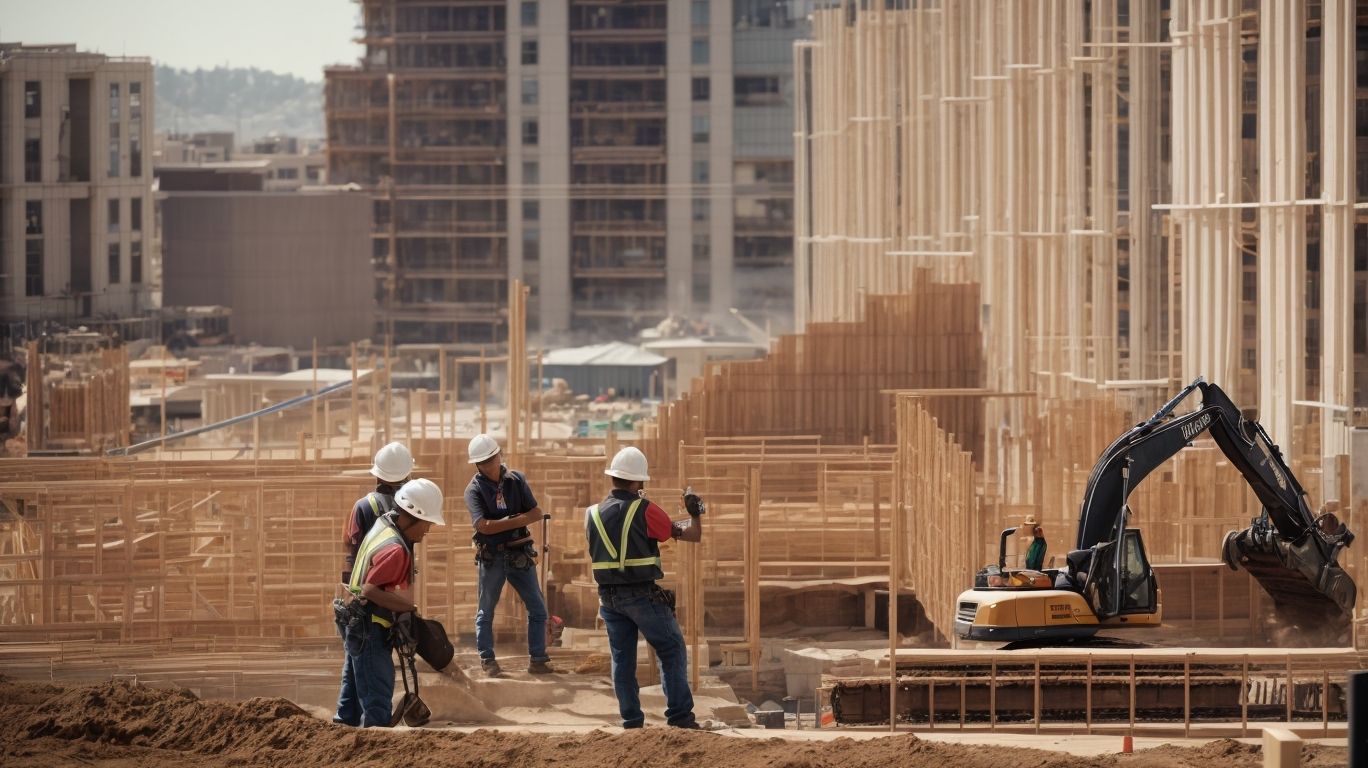
Seamless HVAC Integration in SF: Your Structural Engineering Solution
In the world of structural engineering, the seamless integration of HVAC (Heating, Ventilation, and Air Conditioning) systems plays a critical role in ensuring the efficiency, functionality, and overall success of a building project. In this article, we will explore the concept of HVAC integration, its significance for structural engineering, and the key components involved.
We will delve into the working mechanism of HVAC integration, the benefits it offers, as well as the challenges that arise, particularly in the context of San Francisco. We will discuss the pivotal role that structural engineers play in facilitating the smooth integration of HVAC systems, from site assessments to compliance with building codes. Join us as we uncover the intricacies of seamless HVAC integration in San Francisco and gain valuable insights into how it can be a game-changer for your structural engineering endeavors.
What Is HVAC Integration?
HVAC integration refers to the seamless incorporation of heating, ventilation, and air conditioning systems into a building’s design and construction.
It plays a vital role in optimizing building performance and energy efficiency. By integrating HVAC systems with smart mechanical engineering and energy-efficient solutions, construction practices can be upgraded to ensure better indoor air quality and temperature control. This integration also helps in reducing energy consumption and operational costs, making it a significant consideration in modern building design.
The synergy between HVAC integration and construction practices is essential in creating sustainable and comfortable indoor environments while meeting stringent energy efficiency standards.
Why Is It Important for Structural Engineering?
HVAC integration holds significant importance for structural engineering as it involves the integration of building systems, energy analysis, and structural considerations to optimize the overall building performance.
This integration has a profound impact on building envelope design, as properly integrated HVAC systems can influence the distribution of loads and thermal effects within the building structure. Structural analysis is also crucially affected, as the placement and design of HVAC components must consider the structural integrity of the building.
The synergy between HVAC and structural engineering contributes to the development of energy-efficient solutions, as efficient HVAC integration can directly impact the energy consumption and sustainability of the building.
What Are the Components of HVAC Integration?
The components of HVAC integration encompass various elements such as ductwork, vents, registers, thermostats, and controls, all integral to the seamless incorporation of mechanical systems into building design.
These components play crucial roles in ensuring effective heating, ventilation, and air conditioning solutions within a built environment. Ductwork facilitates the efficient distribution of conditioned air, while vents and registers enable proper airflow and temperature regulation. Meanwhile, thermostats and controls serve as the central command for maintaining optimal indoor climate, allowing for energy-efficient operation. Together, these elements form a comprehensive system that harmonizes mechanical systems with building infrastructure, promoting comfort, air quality, and energy savings.
Ductwork
Ductwork plays a crucial role in HVAC integration, facilitating the efficient distribution of conditioned air throughout the building, requiring meticulous mechanical design and energy-efficient construction engineering.
It serves as the circulatory system of the HVAC network, ensuring that the heated or cooled air reaches every corner of the space. Properly designed ductwork not only optimizes HVAC system performance and energy efficiency but also contributes to maintaining indoor air quality.
From the selection of materials to the layout and sizing, every aspect of ductwork design impacts the overall functionality of the HVAC system. Consequently, integrating ductwork into mechanical design has become increasingly significant for constructing sustainable, energy-efficient buildings.
Vents and Registers
Vents and registers are essential components in HVAC integration, contributing to sustainable design through efficient HVAC controls and the use of appropriate building materials for optimal indoor air quality.
They play a crucial role in ensuring proper air distribution throughout the building, allowing for effective temperature regulation and ventilation. By strategically placing vents and registers, HVAC systems can minimize energy consumption, improve air circulation, and maintain comfortable indoor environments. These components also influence the selection of building materials, as proper placement and sizing of vents and registers can optimize airflow and ensure even distribution of conditioned air, thus impacting the overall efficiency and performance of the HVAC system.
Thermostats and Controls
Thermostats and controls form an integral part of HVAC integration, enabling efficient energy management and building automation, ultimately leading to substantial energy savings in building operations.
They allow for the precise regulation of heating, cooling, and ventilation systems, optimizing the use of energy resources. By maintaining specific temperature settings and monitoring environmental conditions, these devices contribute to the overall energy efficiency of a building.
With the advancements in building automation technology, smart thermostats and controls can be integrated to provide real-time data and insights, allowing for proactive adjustments and predictive maintenance to further enhance energy savings and overall system performance.
How Does HVAC Integration Work?
HVAC integration involves a multi-phase process encompassing planning, design, coordination with structural engineering, and subsequent installation and testing, fostering the implementation of advanced HVAC technology and energy-efficient design principles for building sustainability.
During the planning phase, careful consideration is given to the building layout and usage patterns to optimize the HVAC system’s efficiency. The design phase involves creating detailed plans for ductwork, insulation, and equipment placement, aiming to maximize energy savings and indoor air quality. Coordination with structural engineers is crucial to ensure the integration of HVAC elements seamlessly into the building’s infrastructure.
The installation and testing phase focuses on implementing cutting-edge HVAC technology and conducting thorough assessments to verify system performance and energy efficiency.
Planning and Design
The initial phase of HVAC integration involves meticulous planning and design, focusing on sustainable construction, building efficiency, and the integration of mechanical infrastructure within the overall building development.
This entails considering factors such as energy efficiency, indoor air quality, and the utilization of renewable energy sources. Sustainable construction practices play a crucial role in reducing the environmental impact of HVAC systems. Building efficiency considerations encompass the selection of appropriate equipment, ductwork design, and control systems to ensure optimal performance.
The incorporation of mechanical infrastructure involves space allocation for HVAC equipment, ducts, and ventilation systems, all of which are essential for a well-integrated HVAC system within a building.
Coordination with Structural Engineering
Effective coordination with structural engineering is paramount in HVAC integration, ensuring seamless retrofitting, energy conservation, and the integration of mechanical infrastructure within the building’s structural framework.
This collaboration is essential for optimizing space utilization and ensuring that HVAC systems function efficiently without compromising the structural integrity of the building. By working closely with structural engineers, HVAC professionals can identify innovative energy conservation strategies that not only enhance the building’s sustainability but also reduce operational costs.
The integration of mechanical infrastructure within the building’s framework demands a thorough understanding of the structural elements, allowing for the seamless incorporation of ventilation, heating, and air conditioning systems while maintaining the building’s overall stability and safety.
Installation and Testing
The final phases of HVAC integration encompass installation and rigorous testing, requiring the expertise of HVAC engineering, and aiming for building optimization through the implementation of energy-efficient practices.
This crucial stage involves the meticulous coordination of various components, from ventilation systems to advanced control mechanisms. HVAC engineers play a pivotal role in ensuring that the installation aligns with sustainable building optimization strategies, emphasizing the integration of energy-efficient technologies to minimize environmental impact.
The testing phase involves comprehensive analysis and evaluations to validate the system’s functionality and energy efficiency, ensuring it complies with industry standards and regulations for sustainable building practices.
What Are the Benefits of Seamless HVAC Integration?
Seamless HVAC integration offers numerous benefits, including:
- Improved energy efficiency
- Enhanced indoor air quality
- Substantial cost savings
- The effective implementation of sustainable energy solutions through advanced HVAC controls.
This integration optimizes the performance of heating, ventilation, and air conditioning systems, leading to reduced energy consumption and lower utility bills. It also ensures a comfortable and healthy indoor environment by regulating temperature and humidity levels.
The seamless integration of HVAC systems promotes the adoption of sustainable energy solutions, such as geothermal or solar power, contributing to a greener and more environmentally friendly approach to heating and cooling.
Improved Energy Efficiency
Seamless HVAC integration contributes to improved energy efficiency, optimizing building performance, minimizing energy consumption, and fostering energy optimization through advanced analysis and implementation.
This integration allows for the synchronization of heating, ventilation, and air conditioning systems with building management controls, ensuring that the energy usage is optimized based on current occupancy and operational needs. By seamlessly integrating HVAC systems, buildings can achieve consistent and comfortable indoor conditions while minimizing wasteful energy consumption. This not only reduces operational costs but also contributes to a more sustainable and environmentally friendly approach to building management.
Better Indoor Air Quality
Seamless HVAC integration significantly improves indoor air quality, ensuring optimal thermal comfort and ventilation, facilitated by efficient mechanical ventilation systems within the building.
This integrated approach to HVAC systems not only maintains comfortable temperatures but also plays a crucial role in circulating clean and fresh air throughout the indoor environment. By effectively removing pollutants and controlling moisture levels, the enhanced ventilation systems create a healthy and pleasant atmosphere for occupants.
Precise thermal comfort considerations ensure that the air distribution maintains consistent temperatures while preventing drafts and maintaining humidity levels at an optimal range. The mechanical ventilation further contributes to these improvements by efficiently exchanging stale indoor air with filtered outdoor air, creating a balanced and high-quality indoor air environment.
Cost Savings
Seamless HVAC integration leads to significant cost savings through efficient energy management, reduced energy consumption, and the implementation of advanced energy-efficient technologies within the building infrastructure.
This seamless integration enables the HVAC system to operate at optimal levels, reducing energy waste and unnecessary costs. By leveraging smart controls and automation, buildings can adjust their heating and cooling based on real-time occupancy and environmental conditions, further enhancing energy efficiency. In addition, the incorporation of energy-efficient technologies like variable refrigerant flow systems and high-efficiency HVAC equipment contributes to long-term cost savings by lowering maintenance and operational expenses.
Seamless HVAC integration presents a compelling financial advantage for building owners and managers looking to improve their energy management strategies and reduce operational costs.
Enhanced Comfort and Control
Seamless HVAC integration enhances overall comfort and control within the building environment, facilitated by advanced building automation systems and optimized indoor climate control functionalities resulting from efficient HVAC design.
This integration allows for precise regulation of temperature, humidity, and air quality, creating a harmonious indoor environment. Building occupants benefit from the consistent comfort levels achieved through intelligent zoning and automated adjustments. The efficient coordination of HVAC systems with building automation technology ensures energy savings while maintaining optimal comfort.
The seamless integration minimizes manual intervention, offering hassle-free control and monitoring of the indoor climate. It contributes to a more productive, healthier, and sustainable building environment.
What Are the Challenges of HVAC Integration in SF?
HVAC integration in San Francisco presents specific challenges related to building codes and regulations, climate considerations, and the adoption of energy-efficient construction practices, necessitating strategic solutions tailored to the unique environment.
These challenges stem from the diverse climate conditions in San Francisco, where temperature variations and humidity levels can impact HVAC system performance. Stringent building codes in the city require careful consideration of ventilation and air quality standards to ensure occupant health and safety. The demand for energy-efficient construction solutions is further amplified by the city’s commitment to sustainability and reducing environmental impact.
Overcoming these challenges requires collaboration between architects, engineers, and contractors to design and implement HVAC systems that meet regulatory requirements and optimize energy usage.
Limited Space
The limited space in San Francisco poses a notable challenge for HVAC integration, impacting building infrastructure, retrofit projects, and building renovation endeavors, requiring innovative solutions for optimal integration.
This spatial constraint necessitates careful consideration of space-efficient HVAC systems, such as variable refrigerant flow (VRF) systems and compact ductless mini-split units, to effectively meet the heating and cooling needs of structures within the city. Integrating these systems often involves creative positioning and strategic utilization of available space, often implying custom designs to fit within the confines of existing buildings.
The demand for retrofits and renovations in historic and older buildings further accentuates the need for adaptable HVAC solutions that preserve the architectural integrity while ensuring efficient and comfortable indoor environments.
Building Codes and Regulations
Compliance with stringent building codes and regulations poses a significant challenge for HVAC integration in San Francisco, necessitating meticulous construction management and the adoption of building structural solutions to ensure regulatory compliance.
These regulations cover a broad spectrum of aspects, such as fire safety, seismic resilience, energy efficiency, and accessibility. Meeting these complex requirements demands close collaboration between architects, engineers, contractors, and local authorities.
The diverse topography and historical significance of many buildings in San Francisco add another layer of complexity to compliance efforts, often requiring innovative solutions to balance modern functionality with preservation mandates.
Climate Considerations
The unique climate considerations in San Francisco pose challenges for HVAC integration, necessitating a focus on indoor environmental quality, sustainable construction practices, and the adoption of energy-efficient systems tailored to the local climate.
Consideration of indoor environmental quality is crucial in San Francisco due to the city’s varying microclimates and temperature fluctuations. Sustainable construction practices, such as passive design strategies and high-performance building materials, are essential for reducing energy demand.
The adoption of energy-efficient HVAC systems, such as variable refrigerant flow (VRF) systems and heat pumps, is vital to ensure optimal performance in San Francisco’s specific climate conditions.
How Can Structural Engineers Help with HVAC Integration in SF?
Structural engineers play a vital role in facilitating HVAC integration in San Francisco through their expertise in building projects, offering innovative building structural solutions and comprehensive construction solutions tailored to the unique environment.
Their deep understanding of the local climate and seismic considerations allows them to create robust and efficient HVAC systems that can withstand the city’s specific challenges. By collaborating closely with architects and construction teams, structural engineers ensure that the HVAC integration seamlessly fits into the overall building design, optimizing space utilization and energy efficiency. Their contributions not only enhance the comfort and functionality of buildings but also align with the city’s sustainability goals, making San Francisco a leader in environmentally conscious urban development.
Conducting Site Assessments
Structural engineers aid in HVAC integration by conducting comprehensive site assessments, contributing to the design of building infrastructure and the implementation of energy-efficient solutions tailored to the specific requirements of the site.
Their expertise ensures that the HVAC systems are seamlessly integrated within the building’s structure, optimizing space utilization and airflow dynamics. By evaluating load-bearing capacities and structural constraints, these professionals offer valuable insights for the efficient placement and installation of HVAC units. Their assessment includes considerations for sustainability and environmental impact, leading to the incorporation of advanced energy-efficient technologies and practices to enhance the overall building performance.
Designing Structural Support Systems
Structural engineers contribute to HVAC integration by designing robust structural support systems, fostering sustainable design principles, and ensuring the effective integration of mechanical infrastructure for ongoing building maintenance.
Their expertise in analyzing building loads and creating support structures ensures that HVAC components are securely integrated without compromising the structural integrity of the building. By incorporating sustainable design considerations, such as optimizing natural ventilation and passive heating, engineers can minimize the energy consumption of HVAC systems.
They collaborate with mechanical engineers to seamlessly integrate ductwork and equipment, optimizing space utilization while facilitating easy access for maintenance and repairs. This holistic approach not only enhances the overall efficiency and longevity of the building systems but also aligns with environmentally friendly practices.
Coordinating with HVAC Contractors
Structural engineers provide valuable coordination with HVAC contractors, facilitating building upgrades, ensuring seamless HVAC implementation, and contributing to effective construction design for optimal integration.
They play a crucial role in understanding the structural elements of a building and how they can accommodate the HVAC systems effectively. This collaboration ensures that the HVAC integration is not only functional but also aligns with the overall architectural vision. By leveraging their expertise, structural engineers enable the seamless incorporation of HVAC systems into the building, considering factors like load-bearing capacity, space utilization, and structural support.
Their involvement in the early stages of design and planning is instrumental in avoiding conflicts and achieving an efficient and cohesive building upgrade.
Ensuring Compliance with Building Codes
Structural engineers ensure strict compliance with building codes, focusing on energy-efficient planning, seamless mechanical integration, and the continuous improvement of building infrastructure for optimized HVAC integration.
Their expertise involves conducting thorough assessments to determine the most suitable designs for HVAC systems, ensuring proper placement of ductwork, vents, and equipment while considering factors such as airflow and energy consumption. They play a key role in implementing sustainable building materials and innovative construction techniques that enhance energy efficiency and support environmentally responsible practices.
By staying abreast of technological advancements, structural engineers can recommend and incorporate cutting-edge HVAC solutions to further elevate the performance and sustainability of buildings.




No Comments